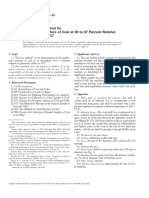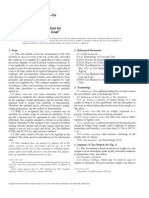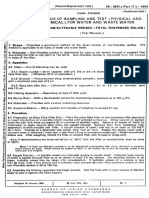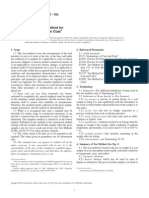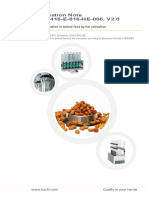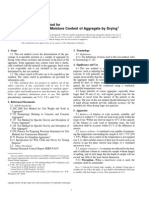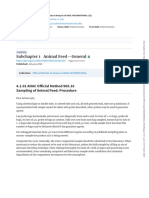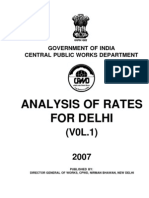Physical and Chemical Methods of Testing Waste Water - Is 3025 - Part 15
Physical and Chemical Methods of Testing Waste Water - Is 3025 - Part 15
Uploaded by
madhuwadiCopyright:
Available Formats
Physical and Chemical Methods of Testing Waste Water - Is 3025 - Part 15
Physical and Chemical Methods of Testing Waste Water - Is 3025 - Part 15
Uploaded by
madhuwadiOriginal Title
Copyright
Available Formats
Share this document
Did you find this document useful?
Is this content inappropriate?
Copyright:
Available Formats
Physical and Chemical Methods of Testing Waste Water - Is 3025 - Part 15
Physical and Chemical Methods of Testing Waste Water - Is 3025 - Part 15
Uploaded by
madhuwadiCopyright:
Available Formats
IS : 3025 (Part 15) - 1984
UDC 628.1/.3 : 543.3 : 543.814 (Reaffirmed 1998) Edition 2.1 (2000-01)
Indian Standard
METHODS OF SAMPLING AND TEST (PHYSICAL AND CHEMICAL) FOR WATER AND WASTE WATER
PART 15
Water Sectional Committee, CDC 26 and Panel for Methods of Test for Water and Effluents, CDC 26 : Pl [Ref : Doc : CDC 26(8847)]
TOTAL RESIDUE (TOTAL SOLIDS DISSOLVED AND SUSPENDED)
( First Revision )
(Incorporating Amendment No. 1) 1. Scope Prescribes a gravimetric method for the determination of total residue. This method is applicable to all types of water and waste water. 2. Principle The sample is evaporated in a weighed dish on a steam-bath and is dried to a constant mass in an oven either at 103-105C or 179-181C. Total residue is calculated from increase in mass.
Note In general, by evaporating and drying water samples at 179-181C values are obtained which conform more closely to those obtained by summation of individually determined mineral salts.
3. Interferences 3.1 Highly mineralized waters containing significant concentration of calcium, magnesium, chloride and/or sulphate may be hygroscopic. These may require prolonged drying, desiccation and rapid weighing. However, prolonged drying may also cause loss of constituents, particularly nitrates and chlorides. 3.2 A large amount of residue in the evaporating basin may crust over and entrap water preventing its evaporation during drying. For this reason, the volume of the sample should be adjusted so that the residue left after drying should be about 100 to 200 mg. 4. Apparatus 4.1 Evaporating Dish of 90 mm diameter, 100 ml capacity made of platinum, nickel, porcelain, silica or borosilicate glass. Platinum is suitable for all tests. Nickel is satisfactory if residue is not to be ignited. Porcelain, silica and glass may be used for samples with a pH value less than 9.0. 4.2 Steam-Bath 4.3 Drying Oven drying oven with thermostatic control for maintaining temperature up to 180 2C. 4.4 Desiccator Provided with a colour indicating desiccant. 4.5 Analytical Balance 200 g capacity and capable of weighing to nearest 0.1 mg. 4.6 Magnetic stirrer with teflon coated stirring bars. 5. Sample Handling and Preservation Preservation of the samples is not practical. Analysis should begin as soon as possible. Refrigeration or chilling to 4C, to minimize microbiological decomposition of solids is recommended. 6. Procedure 6.1 Heat the clean evaporating dish to 180C for 1 hour. Cool, desiccate, weigh and store in desiccator until ready for use. 6.2 Select volume of the sample which has residue between 25 and 250 mg, preferably between 100 and 200 mg. This volume may be estimated from values of specific conductance. To obtain a measurable residue; if necessary, add successive sample portion to the same dish after evaporation. 6.3 Stir volume of sample with a magnetic stirrer or shake it vigorously. Pipette this volume to a weighed evaporating dish placed on a steam-bath. Evaporation may also be performed in a drying oven. The temperature should be lowered to approximately 98C to prevent boiling and splattering of the sample. After complete evaporation of water from the residue, transfer the dish to an oven at Adopted 25 January 1984 BIS 2002 Price Group 1
BUREAU
OF INDIAN STANDARDS
MANAK BHAVAN , 9 BAHADUR SHAH ZAFAR MARG NEW DELHI 110002
IS : 3025 (Part 15) - 1984
103-105C, or 179-181C and dry to constant mass, that is, till the difference in the successive weighings is less than 0.5 mg. Drying for a long duration (usually 1 to 2 hours) is done to eliminate necessity of checking for constant mass. The time for drying to constant mass with a given type of sample when a number of samples of nearly same type are to be analysed should be determined by trial. 6.4 Weigh the dish as soon as it has cooled avoiding residue to stay for long time as some residues are hygroscopic and may absorb water from desiccant which may not be absolutely dry. 7. Calculation Calculate the total residue using the following equation: 1 000 M Total residue, mg/l = --------------------V where M = mass in mg of total residue, and V = volume in ml of the sample. 8. Report Report in whole numbers for less than 100 mg/l and above 100 mg/l to three significant figures. Report the temperature of determination also. 9. Precision and Accuracy The precision of the mathod is about 5 percent. Accuracy cannot be estimated for total residue as determined by this method as it is a quantity defined by the procedure followed.
EXPLANATORY
NOTE
Total residue is the term applied to the material left in the vessel after evaporation of a sample of water and its subsequent drying in an oven at a definite temperature. Total residue includes non-filterable residue (the portion of the total residue retained by a filter), and filterable residue (the portion of the total residue which passes through the filter). This method supersedes 10 of IS : 3025-1964 Methods of sampling and test (physical and chemical) for water used in industry. This edition 2.1 incorporates Amendment No. 1 (January 2000). Side bar indicates modification of the text as the result of incorporation of the amendment. 2
You might also like
- Advanced Temperature Measurement and Control, Second EditionFrom EverandAdvanced Temperature Measurement and Control, Second EditionNo ratings yet
- T236Document4 pagesT236Rishi Gupta100% (1)
- D1412-Standard Test Method For Equilibrium Moisture of Coal at 96 To 97 Percent Relative Humidity and 30 Deg CelciusDocument5 pagesD1412-Standard Test Method For Equilibrium Moisture of Coal at 96 To 97 Percent Relative Humidity and 30 Deg CelciusWelsinsin Kevin SinNo ratings yet
- Aashto T166 275Document11 pagesAashto T166 275Alejandro Pinto100% (1)
- D3302-Standard Test Method For Total Moisture in CoalDocument7 pagesD3302-Standard Test Method For Total Moisture in CoalPradjnaParamitaMichele100% (2)
- Is Code 1200 - 11 Paving, Floor Finishing, Dado, SkirtingDocument11 pagesIs Code 1200 - 11 Paving, Floor Finishing, Dado, Skirtingamitkukna67% (3)
- Is-3025-Part-15-1984-Tests of Water For Total Residue (Total Solids - Dissolved and Suspended)Document2 pagesIs-3025-Part-15-1984-Tests of Water For Total Residue (Total Solids - Dissolved and Suspended)Sachin PawarNo ratings yet
- Mlvss & Mlss Is-3025 - 18Document2 pagesMlvss & Mlss Is-3025 - 18Anuraj20No ratings yet
- SOP AMBL 105A TotalSolidsDocument5 pagesSOP AMBL 105A TotalSolidsWijianto WijiantoNo ratings yet
- First Edition 1st Rev Aug 08 Handbook Environmental ScienceDocument72 pagesFirst Edition 1st Rev Aug 08 Handbook Environmental ScienceAshwin MNo ratings yet
- First Edition 1st Rev Aug 08 Handbook Environmental ScienceDocument72 pagesFirst Edition 1st Rev Aug 08 Handbook Environmental ScienceAshwin MNo ratings yet
- AOCS Official Method Ca 3d Sedimentos en AceiteDocument4 pagesAOCS Official Method Ca 3d Sedimentos en AceiteCarla Sánchez GallardoNo ratings yet
- Standard Test Method For Moisture in The Analysis Sample of Coal and CokeDocument7 pagesStandard Test Method For Moisture in The Analysis Sample of Coal and CokemuchtarNo ratings yet
- NT Build 485 (Edition 2)Document6 pagesNT Build 485 (Edition 2)bkollarou9632No ratings yet
- Soundness Test by Use of Magnesium SulfateDocument9 pagesSoundness Test by Use of Magnesium Sulfatesterces011No ratings yet
- Lab Report Dist 1 Batch DistillationDocument20 pagesLab Report Dist 1 Batch Distillationcsgo accountNo ratings yet
- Disclosure To Promote The Right To InformationDocument6 pagesDisclosure To Promote The Right To InformationnehaNo ratings yet
- D4530Document5 pagesD4530rimi7al100% (1)
- Loss On Drying and Validation of Moisture AnalyzersDocument35 pagesLoss On Drying and Validation of Moisture AnalyzersMubarak PatelNo ratings yet
- Soundness of Aggregates by Use of Sodium Sulfate or Magnesium SulfateDocument34 pagesSoundness of Aggregates by Use of Sodium Sulfate or Magnesium SulfateFaith GandaNo ratings yet
- Aplication Fat Extraction FoodDocument6 pagesAplication Fat Extraction FoodKu BonNo ratings yet
- 1081 Fixing and Glazing SDDocument3 pages1081 Fixing and Glazing SDAjit P. SinghNo ratings yet
- Suspended SolidDocument9 pagesSuspended SolidAmmar MddeniNo ratings yet
- Waqtc BookDocument117 pagesWaqtc BookHaftari HarmiNo ratings yet
- 34) Extraction of Bitumen From Paving MixturesDocument6 pages34) Extraction of Bitumen From Paving MixturesPn EkanayakaNo ratings yet
- Volatile Matter in Green Petroleum Coke Quartz Crucible ProcedureDocument4 pagesVolatile Matter in Green Petroleum Coke Quartz Crucible ProcedureAli VarmazyarNo ratings yet
- Solids, Residue On Evaporation at 105°C, Total, Gravimetric: 1. Application 4. ApparatusDocument2 pagesSolids, Residue On Evaporation at 105°C, Total, Gravimetric: 1. Application 4. ApparatusTonyNo ratings yet
- Determination of Total Solids in Biomass and Total Dissolved Solids in Liquid Process SamplesDocument9 pagesDetermination of Total Solids in Biomass and Total Dissolved Solids in Liquid Process SamplesShahram HawramiNo ratings yet
- Astm OvenDocument8 pagesAstm Ovennurul nabilah bt khairul anuarNo ratings yet
- Amendment No. 1 December 1999 TO Is 3025 (Part 18) : 1984 Methods of Sampling and Test (Physical and Chemical) For Water and WastewaterDocument3 pagesAmendment No. 1 December 1999 TO Is 3025 (Part 18) : 1984 Methods of Sampling and Test (Physical and Chemical) For Water and WastewaterRaghav TiwaryNo ratings yet
- SST e SSVDocument6 pagesSST e SSVnandaum_laNo ratings yet
- Determination of Moisture in FoodsDocument9 pagesDetermination of Moisture in Foodsagdwiyanti100% (1)
- Low Level Measurement of Cadmium in Foods: AA-97 May 1990Document5 pagesLow Level Measurement of Cadmium in Foods: AA-97 May 1990ابزار دقیقNo ratings yet
- TPH From SoilsDocument3 pagesTPH From SoilsAbelNugrahaNo ratings yet
- 13745Document10 pages13745Binayak KumarNo ratings yet
- Laboratory Analytical Procedure: Procedure Title: Author: Date: Issue Date: SupersedesDocument7 pagesLaboratory Analytical Procedure: Procedure Title: Author: Date: Issue Date: SupersedesBryan Roncal LlajarunaNo ratings yet
- Disclosure To Promote The Right To InformationDocument6 pagesDisclosure To Promote The Right To InformationSunny RohillaNo ratings yet
- Total Suspended SolidsDocument3 pagesTotal Suspended SolidsOpata OpataNo ratings yet
- Astm D3302-D3302M-12Document8 pagesAstm D3302-D3302M-12Sendy Arfian SaputraNo ratings yet
- Total Moisture in Coal: Standard Test Method ForDocument7 pagesTotal Moisture in Coal: Standard Test Method ForroylesterlaraNo ratings yet
- Moisture ContentDocument6 pagesMoisture ContentJM BoylesNo ratings yet
- Objective: Oil Stability IndexDocument6 pagesObjective: Oil Stability Indexruben castroNo ratings yet
- Moisture Guide enDocument48 pagesMoisture Guide enJanet TudorNo ratings yet
- KT 39Document6 pagesKT 39nischal_babuNo ratings yet
- Mbpracticas LabDocument6 pagesMbpracticas LabRosa VelásquezNo ratings yet
- EPA Method 8015DDocument5 pagesEPA Method 8015DBrenda AcuñaNo ratings yet
- BSCE 2-2 Group 1 - Experiment 5 PDFDocument8 pagesBSCE 2-2 Group 1 - Experiment 5 PDFLockon StratosNo ratings yet
- EPA Method 105 - Determination ofDocument6 pagesEPA Method 105 - Determination ofphilippe landry NDJOCKNo ratings yet
- Chapter 8. Quality Control of Charcoal and By-ProductsDocument7 pagesChapter 8. Quality Control of Charcoal and By-ProductsKalidhas YogarajanNo ratings yet
- Celda Flash Site Skim Air Test Procedure With PhotosDocument9 pagesCelda Flash Site Skim Air Test Procedure With Photosealfaro6580No ratings yet
- EPA Method 160 1Document3 pagesEPA Method 160 1Gustavo Leonardo Huidobro MussoNo ratings yet
- Astm Summarization For P.T.Document23 pagesAstm Summarization For P.T.Ahmed ElsharkawyNo ratings yet
- C566Document3 pagesC566Jonathan Mendoza Chavez100% (1)
- Subchapter 1 Animal Feed-GeneralDocument55 pagesSubchapter 1 Animal Feed-GeneralGermàn Mauricio Ayala JimènezNo ratings yet
- Grain Size Analysis Procedure 06-12-26Document9 pagesGrain Size Analysis Procedure 06-12-26anthonyNo ratings yet
- What Is Loss On Drying-Total SolidsDocument7 pagesWhat Is Loss On Drying-Total SolidsMuhammad Masoom Akhtar0% (1)
- AutoclaveDocument18 pagesAutoclaveGorwadiya_Hite_1818No ratings yet
- Moisture Analysis 3 2 2Document22 pagesMoisture Analysis 3 2 2CArlosNo ratings yet
- Miscellaneous Determination & Tests: By: Dr. Shumaila ShafiqueDocument28 pagesMiscellaneous Determination & Tests: By: Dr. Shumaila ShafiqueShoaib Muhammad100% (1)
- Standard methods for the examination of water and sewageFrom EverandStandard methods for the examination of water and sewageNo ratings yet
- Casestudytemplatestructurev 9 Aug 15Document1 pageCasestudytemplatestructurev 9 Aug 15madhuwadiNo ratings yet
- Method Statemet SurveyDocument7 pagesMethod Statemet SurveymadhuwadiNo ratings yet
- Analysis of Rates 07 Vol - 2Document650 pagesAnalysis of Rates 07 Vol - 2supriyo.podderNo ratings yet
- Engineering CPWD Analysis of Rates - 1Document571 pagesEngineering CPWD Analysis of Rates - 1javedk_33No ratings yet
- 1659 Block BoardsDocument21 pages1659 Block BoardsmadhuwadiNo ratings yet
- Environment Engineering PDFDocument1 pageEnvironment Engineering PDFmadhuwadiNo ratings yet
- 00 Basic Principles of Asphalt CompactionDocument59 pages00 Basic Principles of Asphalt CompactionAynup Irahtak100% (1)
- Technical Supply Conditions For Threaded Steel Fasteners Is-1367 - 7Document3 pagesTechnical Supply Conditions For Threaded Steel Fasteners Is-1367 - 7madhuwadiNo ratings yet
- 2094 PDFDocument6 pages2094 PDFAkshay KaliaNo ratings yet
- Construction Manager - John J.MckeonDocument214 pagesConstruction Manager - John J.Mckeonmadhuwadi100% (1)
- Is SP 27 1987 - 0 PDFDocument130 pagesIs SP 27 1987 - 0 PDFluckyyermalNo ratings yet
- Contracts & Contracting - NICMAR NCP-23Document20 pagesContracts & Contracting - NICMAR NCP-23madhuwadi100% (2)
- Material & Equipment MGMT - NICMAR NCP-24 25Document22 pagesMaterial & Equipment MGMT - NICMAR NCP-24 25madhuwadi67% (6)
- Organisation MGMT - NICMAR NCP-21Document19 pagesOrganisation MGMT - NICMAR NCP-21madhuwadi100% (1)
- GuwahatiDocument2 pagesGuwahatimadhuwadiNo ratings yet


